When I was a child I used to pore over Mum’s cookbooks in search of deliciousness. Coloured photos were rare and food styling certainly hadn’t been invented but most of these cookbooks had something today’s volumes of food porn lack – a selection of invalids’ dishes.
As I browsed there I had visions of wan faces peeping over white twill sheets, wistfully hoping for some tempting delicacies from the kitchen. My preferences were for toast with canned spaghetti or canned tomato soup.
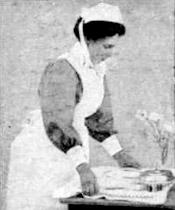
A daintily set tray was the first requirement - flowers, pretty china, tempting tiny servings (1)
The Edmonds cookbook advised those tending the sick should:
- Set the tray daintily
- Serve small helpings
- Cook the food perfectly and serve it attractively
- Use the most attractive china and linen
- Use a flower or small posy on the tray
- Serve one course at a time
Invalid diets come in several categories – milk, liquid, soft, light and full diets – and usually depend on what’s ailing the patient. But some look more like a cause than a cure.
I think a plate of brains that have been boiled, sliced, rolled in egg then breadcrumbs and fried might not really be what the wan face is anticipating.
Apple snow was a favourite across several cookbooks. The pulp from baked apples is sweetened and mixed with stiffly beaten egg white then baked.
Lemon barley water was dispensed from Mum’s home pharmacy. It was one of those concoctions my grandmother said would “cool the blood” as was the ever-popular panacea, Dinnefords administered to colicky babies, delicate females and gouty codgers alike.
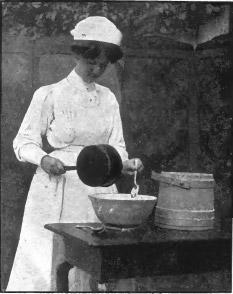
A nurse makes gruel - literally a porridge-flavoured water (1)
The invalids’ dish that made me shudder was steamed fish. A fillet or two were placed in a deep, greased plate and seasoned then the plate was placed on a pan of boiling water and covered with a lid. After 20 or 30 minutes the fish was ready to serve. I imagine it tasted as bland as it looked.
Gruel looked similarly uninviting – generally about a tablespoon of oatmeal was simmered in up to a pint of water then it was strained and a little sugar and salt were added. Porridge water. No thanks. Boiled up sago (1 teaspoon to a cup of water or stock) was further fortified with an egg yolk before serving.
If the poor patient had retained any appetite, it had probably vanished by now.
Then there was arrowroot. For those who couldn’t take milk, the arrowroot custard made instead with water must have been something like wallpaper paste with salt and sugar added, though I did see one recipe recommend flavouring it with a little sherry or port. Florence Nightingale, in her Notes on Nursing said arrowroot was a grand dependence of the nurse. “As a vehicle for wine, and as a restorative quickly prepared, it is all very well but it is nothing but starch and water; flour is both more nutritive and less likely to ferment, and is preferable wherever it can be used.” I say throw out the watery custard and just have a slug of sherry.
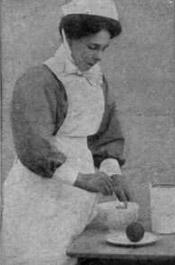
Another cereal-based drink - barley water was often flavoured with lemon (1)
I have the 1946 edition of The American Woman’s Cookbook, first published in 1938 but including content going back to 1927. It was edited and revised by Ruth Berolzheim, director of the Culinary Arts Institute. I was interested to see how American invalids were treated compared with their fellow sufferers Down Under.
There was albumenised milk – cold milk, cracked ice and salt shaken with a beaten egg white. And there was albumen water with water instead of milk. Even the addition of sugar and lemon juice wouldn’t have rescued that recipe for me.
The name panada suggests something fairly exotic, but basically it involved a couple of graham crackers being soaked in boiling water over a double boiler for 20-30 minutes then lifted carefully onto a hot saucer, salted if necessary and served “very hot with sugar and cream”.
A concoction called kumiss must have been quite a challenge to make. The name had a vaguely familiar ring. In 0.16 seconds Google confirmed it. Kumiss or koumiss is
- mare’s or camel’s milk fermented and used as a drink by Tatar nomads of Asia
- a similar drink made from cow’s milk, used in certain special diets
For the American invalid, a quart of milk (animal type not specified but I am assuming cow’s milk for invalids who aren’t Tatar nomads) is heated to 75F (24C) and sugar and dissolved yeast-cake are added and the mixture placed in a bottle, corked tightly and shaken.
“It may be necessary to tie the corks on the bottles, as the yeast causes the milk to ferment and if gas is produced in considerable amounts, the corks are forced out.” Wise to obey, as ginger beer brewers in pre-screwtop fizzy drinks days will testify. Cleaning fermented beverages off the walls is not a lot of fun.
The bottles are inverted and left where they can remain at a 70F (21C) temperature for 10 hours. The milk is then stored in the fridge for 24 hours and shaken occasionally to prevent the cream from forming in the neck of the bottle.
“If left standing for too long, it becomes less palatable.” (Maybe – I read some women deliberately let it brew on and a kind of vodka was the result.) And the maker is warned to open the bottle with care so the milk is not allowed to foam over.
I think the home production of kumiss probably served as a form of psychological warfare. Knowledge of what was going on in the kitchen, and the 24-hour warning of what was to come, may have led to a rapid recovery of the ailing one peeping over the twill sheets – probably just in time to help clean up the kitchen, post-explosion.
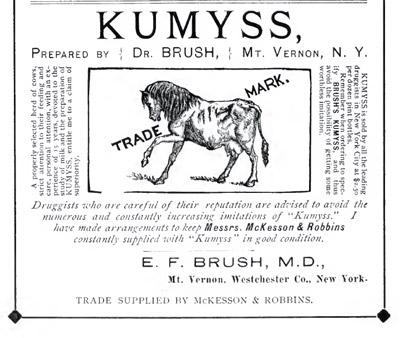
Commercially made kumiss/kumyss was probably a safer, cleaner option (2)
In my old primary school Home Science Recipes quite the strangest recipe I found was for toast water. A slice of stale bread was dried in the oven, toasted till well browned on both sides then placed in a bowl and covered in a cup of boiling water and left for 30 minutes. The results were strained into a tumbler and a squeeze of lemon juice added. I really can’t detect much goodness in there, either. Mrs Beeton was serving up such fare in her 1860s Book of Household Management and noted “if drunk in a tepid or lukewarm state, it is an exceeding disagreeable beverage.” It had to be served cold.
Another Beeton recipe was the toast sandwich – thin cold toast between thin slices of bread and butter.
Spurred on by the writings of Florence Nightingale, Mrs Beeton wisely warned against leaving food in the sick room if the patient could not eat it. Trays of curly toast sandwiches, coddled eggs, unappetising bowls of gruel, cups of whey, festering kumiss…
Fat was an enemy and all sources insisted every last little drop be removed from beef teas and broths. And beef tea was everywhere when if came to fortifying invalids.
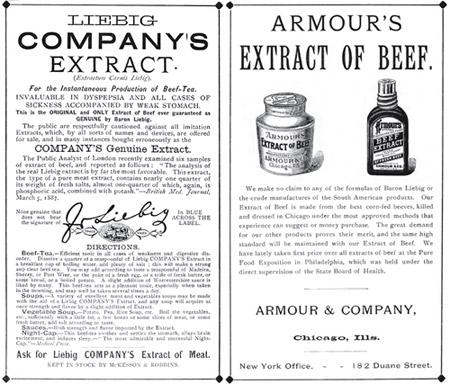
Advertisers quibbled about whose beef extract was best. Liebig Co sniffed that theirs was the only extract of beef ever guaranteed as genuine by Baron Liebig. Armour's proclaimed theirs was made from "the best corn-fed beeves" and they made no claim to any of Baron Liebig's formulas, or crude South American products (2)
Miss Nightingale was a little sceptical about its benefits.
“Just try and boil down a pound of beef into beef-tea. Evaporate your beef-tea and see what is left of your beef; you will find that there is barely a teaspoon of solid nourishment to half a pint of water in beef tea. Nevertheless there is a certain reparative quality in it – we do not know what – as there is in tea; but it may safely be given in almost any inflammatory disease, and is as little to be depended upon with the healthy or convalescent, where much nourishment is required.”

My grandmother's favourite "blood-cooling" remedy - Dinneford's magnesia (3)
These days the invalid is rarely lucky enough to have someone available in the kitchen to whip up little treats. Everyone else is out at work. Instead the ailing make sad little comments on Twitter or Facebook and hope one of their mates will take pity and drop by with sustenance. Or they end up with toast and Vegemite or a bowl of instant noodles.
Illustrations
- Every Woman’s Encyclopaedia, Various Authors, London, 1910-1912
- Prices current of drugs, chemical and pharmaceutical preparations, proprietary medicines, corks, dyes, paints, McKesson and Robbins, New York, 1889
- http://paperspast.natlib.govt.nz

